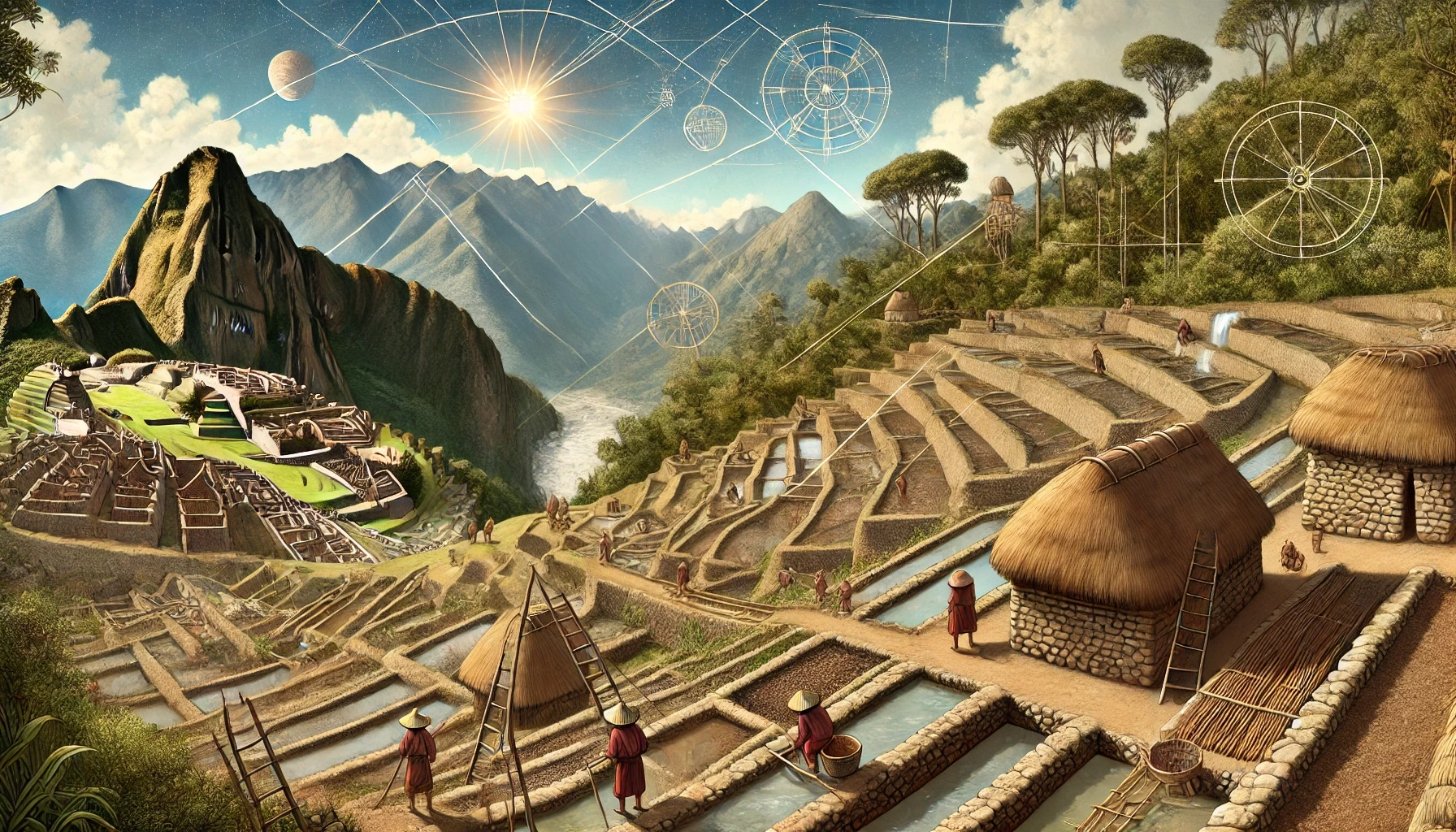What Science and Technology Did the Inca Have?
Introduction
What Science and Technology Did the Inca Have? The Inca civilization, which thrived in the Andean region of South America from the early 13th century until the Spanish conquest in the 16th century, was one of the most advanced societies in the pre-Columbian Americas. Despite the lack of certain fundamental tools like the wheel or written language, the Inca excelled in science, engineering, and technology, developing innovative solutions to challenges posed by their environment.
This article explores the fascinating science and technological achievements of the Inca civilization, showcasing their ingenuity and enduring legacy.
Science and Technology: Agricultural Innovations
The Andean terrain, with its steep mountains and diverse climate, posed significant challenges to farming. However, the Incas developed advanced agricultural techniques to overcome these obstacles.
1. Terracing
The Inca created agricultural terraces on the slopes of mountains, turning otherwise unusable land into fertile farming grounds. These terraces:
- Prevented soil erosion.
- Conserved water by slowing runoff.
- Allowed the cultivation of crops at varying altitudes, adapting to different microclimates.
2. Irrigation Systems
The Inca built extensive irrigation networks, including canals, aqueducts, and reservoirs, to distribute water across arid regions. Some systems, such as those in the Sacred Valley, are still in use today.
3. Crop Domestication
The Incas domesticated a wide range of crops, including:
- Potatoes: They cultivated over 3,000 varieties adapted to different climates.
- Maize: Grown in lower altitudes and essential to their diet.
- Quinoa: A high-protein grain, ideal for high-altitude conditions.
4. Agricultural Experimentation
At Moray, an archaeological site with circular terraces, the Incas conducted agricultural experiments. The varying levels of these terraces simulated microclimates, helping the Incas study how crops grew under different environmental conditions.
Science and Technology: Architecture and Engineering
The Inca were master builders, renowned for their monumental architecture and engineering feats that blended practicality with aesthetics.
1. Stonework
The Inca’s stone masonry remains one of the most remarkable aspects of their technology. Structures like Machu Picchu and Sacsayhuamán showcase:
- Precisely cut stones fitted together without mortar.
- Earthquake-resistant construction, as the interlocking stones absorbed seismic shocks.
- Sustainability, with many structures enduring centuries without significant deterioration.
2. Roads and Bridges
The Inca built an extensive road network, known as the Qhapaq Ñan, stretching over 24,000 miles across their empire. Features include:
- Roads paved with stone, spanning diverse terrains from deserts to mountains.
- Suspension bridges made of grass and plant fibers, such as the famous Q’eswachaka Bridge, which is still rebuilt annually by local communities.
3. City Planning
Inca cities were meticulously planned. Cusco, the empire’s capital, was designed in the shape of a puma, symbolizing strength. Inca urban design included:
- Drainage systems to prevent flooding.
- Buildings aligned with astronomical events.
- Central plazas for administrative and religious activities.
Science and Technology: Astronomy and Calendars
The Inca were keen observers of the sky, and astronomy played a central role in their agriculture, religion, and governance.
1. Solar Observatories
The Inca built structures like the Intihuatana stone at Machu Picchu, which functioned as solar observatories. These tools:
- Tracked the movements of the sun.
- Determined solstices and equinoxes, guiding agricultural activities.
2. Lunar Observations
The Incas also studied the moon’s phases and incorporated them into their calendar. They used lunar cycles to time planting and harvesting.
3. Constellations
The Inca identified dark constellations (patterns formed by dark nebulae in the Milky Way) as well as bright star constellations. These celestial features were linked to myths and agricultural practices.
Science and Technology: Medicine and Surgery
The Inca achieved significant advancements in medicine, combining practical knowledge of plants with spiritual practices.
1. Herbal Medicine
The Incas used an extensive array of medicinal plants to treat various ailments. Examples include:
- Coca leaves: Used for pain relief and altitude sickness.
- Quinine (from cinchona tree bark): An effective treatment for malaria.
- Chili peppers: Applied to reduce swelling.
2. Trepanation (Skull Surgery)
The Inca were skilled in trepanation, the surgical removal of part of the skull to treat head injuries or relieve pressure. Archaeological evidence shows:
- Patients often survived these procedures, as indicated by healed skulls.
- Techniques evolved over time, with increasing success rates.
Science and Technology: Mathematics and Record-keeping
The Incas lacked a written language but developed alternative methods for record-keeping and communication.
1. Quipu
The quipu was a system of knotted strings used to record numerical and narrative information. Features include:
- Knots and thread colors represent different data.
- Uses in accounting, census-taking, and storytelling.
- Deciphering quipu remains a challenge for modern researchers.
2. Decimal System
The Inca used a base-10 system for counting, which was reflected in their administrative and military organization.
Science and Technology: Military Technology
The Inca military was a formidable force, thanks to its advanced technology and strategic planning.
1. Weapons
The Inca crafted weapons such as:
- Slings (huaracas): Used to hurl stones with great force.
- Clubs and maces: Made with metal or stone heads.
- Bolas: Weighted cords used to entangle enemies.
2. Armor
They used protective gear like shields, helmets, and padded armor made from woven cloth.
3. Fortifications
Inca fortresses, such as Sacsayhuamán, were strategically located and designed with robust defensive features, including zigzag walls to repel invaders.
Science and Technology: Transportation and Communication
1. Llamas and Alpacas
The Inca relied on llamas and alpacas for transportation, as they were well-suited to the rugged Andean terrain.
2. Chasquis (Messengers)
The chasquis were runners who carried messages and goods across the empire. Relay stations along the road network allowed swift communication over long distances.
Environmental Sustainability
The Incas were pioneers in environmental sustainability, adopting practices that balanced human needs with nature.
1. Water Management
In addition to irrigation, they built rainwater harvesting systems and canals to prevent flooding.
2. Soil Conservation
The use of terraces minimized erosion and maintained soil fertility.
3. Biodiversity
By cultivating diverse crops and maintaining genetic varieties, the Incas ensured food security.
Legacy of Inca Science and Technology
The Inca’s scientific and technological innovations continue to inspire and influence modern practices. Examples include:
- Modern agricultural techniques derived from Inca methods.
- Hydrological engineering projects inspired by Inca irrigation systems.
- Continued use of their road networks and terraces in contemporary Andean communities.
Conclusion
The Inca civilization, despite its lack of certain tools and written language, developed an extraordinary array of scientific and technological achievements. Their advancements in agriculture, architecture, medicine, and astronomy reflect a deep understanding of their environment and a commitment to innovation.
The Inca legacy serves as a testament to human ingenuity, reminding us of the remarkable potential of science and technology to address challenges and improve lives. By studying and preserving their achievements, we honor their contributions to global heritage and draw inspiration for future advancements.
For More Information, Have a look at more Articles on NetworkForbe






